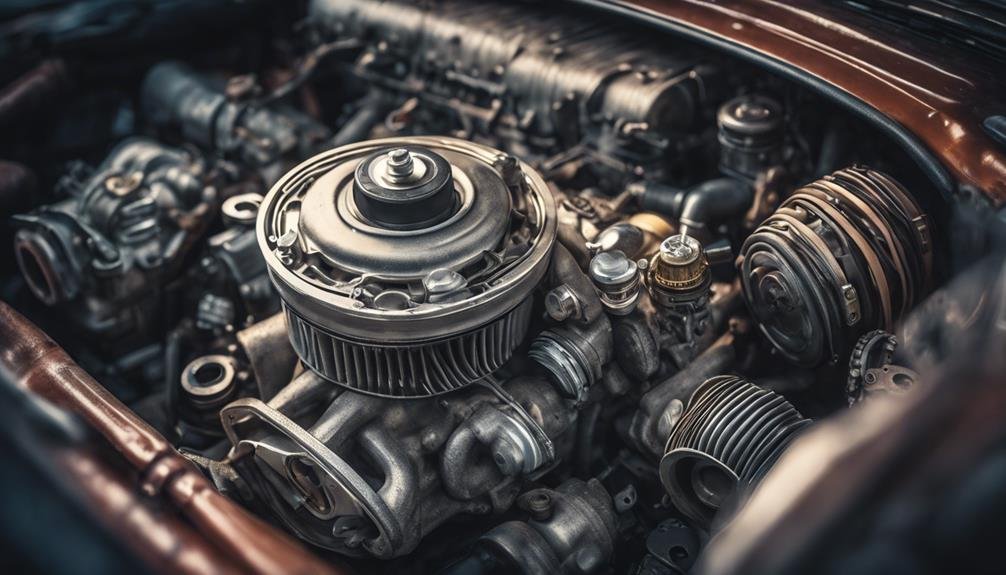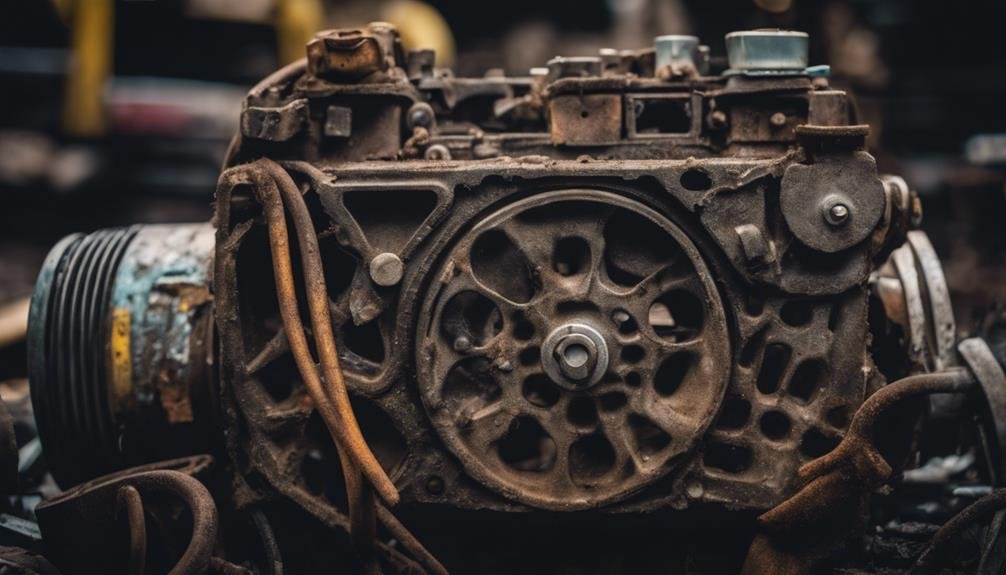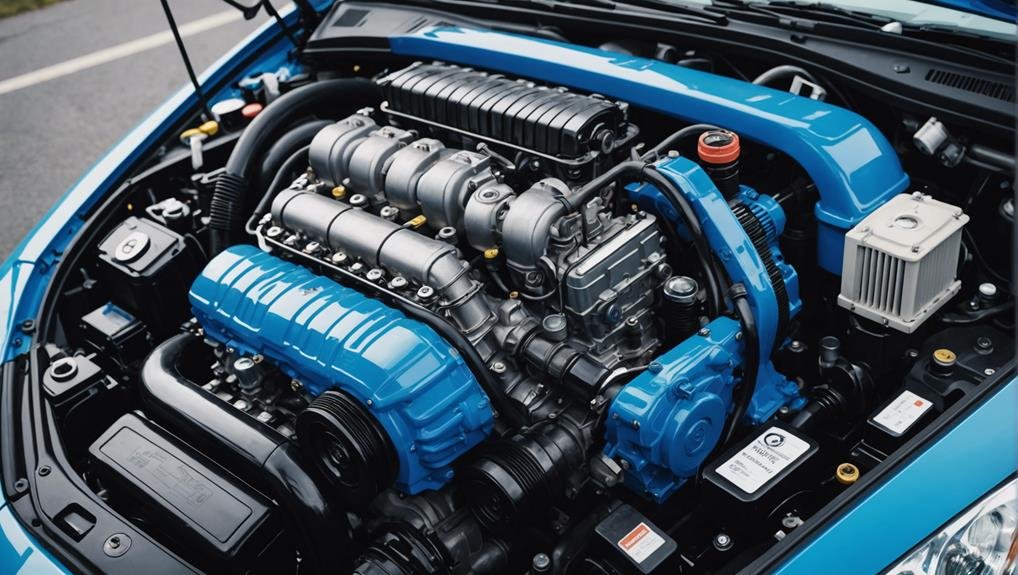Your serpentine belt plays a vital role in powering different engine components, including the alternator, power steering pump, and air conditioning compressor, by transferring power from the crankshaft to these accessories, thereby ensuring a smooth, comfortable, and safe driving experience. It simplifies engine maintenance by consolidating multiple belts into one, making it important for maintaining a comfortable cabin temperature. As you investigate the inner workings of your vehicle, you'll realize the significance of regular inspections and timely replacements to prevent costly repairs and breakdowns.
Key Takeaways
- The serpentine belt powers essential engine components like the alternator, power steering pump, and air conditioning compressor.
- It transfers power from the crankshaft to these engine accessories, simplifying engine maintenance.
- The serpentine belt ensures a comfortable cabin temperature by powering the air conditioning compressor.
- It plays a vital role in powering the alternator, which charges the car's battery and electrical system.
- The serpentine belt also assists with steering by providing necessary power to the power steering pump.
Serpentine Belt Functionality Explained
As you pop the hood of your vehicle, you'll notice a single, long belt winding its way around different engine components – this is the serpentine belt, responsible for powering important systems like the alternator, power steering pump, and air conditioning compressor.
This belt is a critical part of your engine, serving as a single, necessary component that drives multiple engine accessories. The serpentine belt's primary function is to transfer power from the crankshaft to these engine accessories, making sure they operate smoothly and efficiently.
One of the key benefits of the serpentine belt is its ability to simplify engine maintenance by consolidating multiple belts into one. This design allows for easier replacement and reduces the risk of engine damage.
The belt's role in powering the air conditioning compressor, for instance, is essential for maintaining a comfortable cabin temperature. By understanding the serpentine belt's functionality, you'll appreciate the importance of regular maintenance to guarantee your vehicle runs smoothly and efficiently.
Powering Engine Accessories Smoothly
You depend on your vehicle's engine accessories to function properly, and the serpentine belt plays a vital role in powering them smoothly. The serpentine belt is responsible for effectively powering important engine accessories like the alternator, power steering pump, and air conditioner.
By doing so, it guarantees that these vital components are running smoothly, allowing you to enjoy a comfortable and safe driving experience. The power steering pump, for instance, relies on the serpentine belt to provide the necessary power to assist with steering, making it easier to maneuver your vehicle.
Likewise, the air conditioner depends on the serpentine belt to function properly, providing you with a cool and comfortable cabin on hot days. The serpentine belt's ability to power these engine accessories smoothly is critical to the performance of your vehicle.
Without it, these vital components wouldn't function as intended, leading to a range of problems that could leave you stranded on the side of the road.
Importance of Regular Inspections

Regular inspections of your serpentine belt are crucial in preventing costly repairs down the road, and catching potential issues before they leave you stranded. By regularly examining your serpentine belt, you can identify potential problems before they cause damage to your engine.
Here are some key things to look for during an inspection:
- Visible signs of wear: Check for cracks, fraying, or wear on the belt's surface.
- Dashboard warning lights: Don't ignore warning lights related to the belt system, as they can indicate underlying issues.
- Unusual noises: Squealing or chirping noises from the engine can be a sign of serpentine belt issues that require inspection.
Professional inspections can accurately determine the condition of your serpentine belt and ensure proper functioning of engine components. Failing to inspect your serpentine belt regularly can lead to engine overheating and damage.
Signs of a Failing Serpentine Belt
Warning signs of a failing serpentine belt can creep up on you suddenly, but being aware of the indicators can help you take prompt action and avoid costly repairs.
You might hear squealing or chirping noises coming from the engine, which is a clear indication that the belt is failing. Visually inspecting the belt can also reveal signs of wear, such as visible cracks, fraying, or wear on the belt's surface.
If you notice engine overheating or power steering failure, it could be related to a failing serpentine belt. Moreover, dashboard warning lights related to the belt system may illuminate, signaling a potential issue.
Any unusual smell coming from the engine could also be a sign of a failing serpentine belt. Addressing these signs of failure promptly is crucial to prevent further damage to your vehicle's engine and other components.
Consequences of Neglecting Replacement

If you ignore the warning signs and neglect to replace the serpentine belt, you're risking a cascade of costly and frustrating consequences that can leave you stranded on the side of the road. As a significant part of your car's engine, the serpentine belt plays a vital role in maintaining the general health of your vehicle. Neglecting replacement can lead to a series of issues that can be detrimental to your car's performance and longevity.
Here are just a few consequences of neglecting serpentine belt replacement:
- Engine Overheating: A worn-out belt can cause your engine to overheat, leading to costly repairs and potentially catastrophic damage.
- Power Steering and Alternator Issues: Failure to replace the belt can result in power steering and alternator malfunctions, making it difficult to steer and causing electrical system failures.
- AC Compressor Malfunction: A worn-out serpentine belt can cause the AC compressor to malfunction, leaving you without air conditioning on hot summer days.
Routine maintenance, including timely serpentine belt replacement, is vital to avoid these consequences of neglecting replacement. Don't wait until it's too late – prioritize your car's health and avoid the hassle and expense of costly repairs.
Replacement and Maintenance Tips
Your car's serpentine belt relies on you to replace it at the right time, and doing so can save you from a world of trouble down the road. To avoid engine damage, you need to replace your serpentine belt every 60,000-100,000 miles.
Keep an eye out for signs of a bad serpentine belt, such as cracking, glazing, and unusual noises. If you notice any of these signs, don't hesitate to take your car to a certified technician for inspection and replacement.
Regular maintenance and inspection by certified technicians are essential for top performance. Remember, failure to replace a worn serpentine belt can lead to power steering failure, battery drain, and engine damage.
Frequently Asked Questions
What Are the Symptoms of a Bad Serpentine Belt?
You'll know your serpentine belt is failing if you notice unusual engine noises, squealing or chirping sounds, or signs of wear like cracking, glazing, or fraying, which can lead to power steering issues, battery drainage, or engine performance problems.
What Happens to a Car When the Serpentine Belt Breaks?
When your serpentine belt breaks, you'll lose power steering assist, air conditioning, and alternator function, causing electrical system failure, overheating, and possibly leaving you stranded with a dead car that won't start.
How to Know if a Serpentine Belt Needs Replacing?
You'll know your serpentine belt needs replacing when you notice signs of wear like cracks, glazing, or fraying, or if you hear squealing noises, experience power steering failure, or see the Check Engine Light come on.
How Much Does It Cost to Replace a Serpentine Belt?
You're wondering how much it'll cost to replace your serpentine belt, and the answer is it'll likely run you between $75 to $200, depending on your vehicle's make and model, with labor costs varying depending on the mechanic.
Conclusion
You've now understood the crucial role the serpentine belt plays in powering your engine's accessories, ensuring a smooth and efficient ride.
Remember, neglecting regular inspections and replacement can lead to costly repairs, engine damage, and even breakdowns.
Stay on top of maintenance, and your serpentine belt will continue to work tirelessly behind the scenes, keeping your vehicle running like a well-oiled machine.
